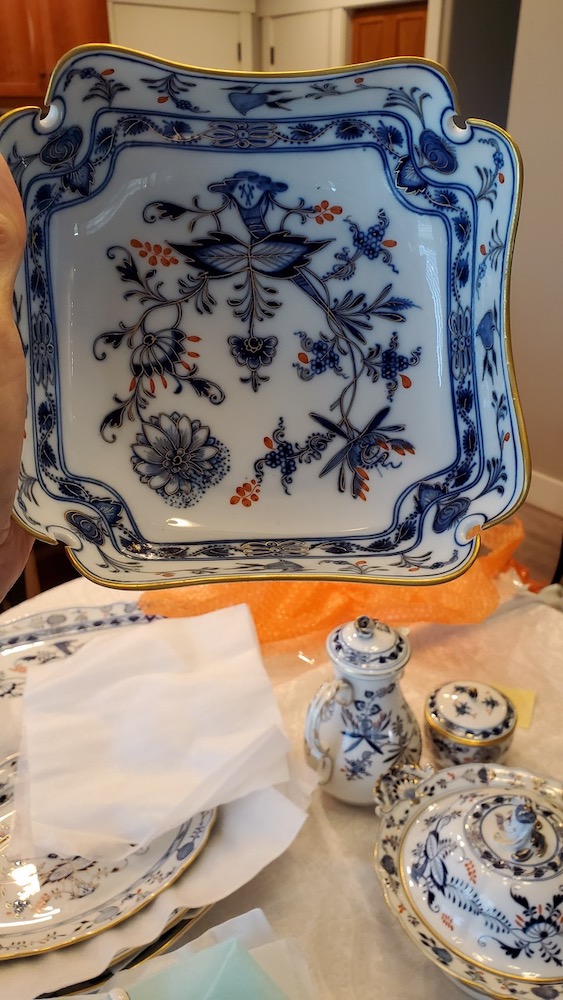What to Do with Fine China?

What can D do with his fine porcelain dinnerware? This is a question I hear weekly. The market for ceramics has softened across the board due in part to the lack of young buyers. Think of those matched service pieces we Boomers/Gen X’ers requested on our wedding registries: so many sets out in the market today originated on wedding registries, thus the market for matched sets is terrible.
If you are intrigued with porcelain in spite of the climate of the market, and you enjoy your matched service on a nicely set table, read Edmund de Waal’s 2015 book, The White Road: Journey into an Obsession. This story of the discovery of porcelain in China one thousand years ago, and the discovery in Europe a mere 300 years ago, is filled with treachery and desire; kings and noblemen would literally kill to own porcelain. De Waal writes: “This level of materialism, after all, is never about necessity. There are the pleasures of being envied and the pleasures of being feared and the pleasures of looking down on a sea of new possessions. But of all the pleasures,” he writes, “MORE is the only thing that works.”
Two factors influence the public disdain for buying fine china today: one is the general decline in formal dining, and the other is the lack of time available to any of us now in our gustatory family lives – we just don’t eat together unhurriedly anymore. Couple that with a trend to favor experience over objects, and a shift away from generational family life; children grow up not owning physical things but partake of movies on Netflix, books on Rakuten, records and LPs in the ether. I came across a collection of coins in those little blue books (remember those?) and wondered what my grandkids might store in boxes in their attics in 2084.
There was a familial, social side to fine china: setting the table was a rite of passage as a young (sorry – typically female) teen. There’s a social side to collecting. My friend was a Wedgwood collector and attended the Wedgwood International Seminar, an annual worldwide conference in early May. This year it just happened to be held in Pasadena. (As an aside, Wedgwood’s founder was the second European potter to discover how to make and fire porcelain.) Wedgwood International Seminar attendance used to be 300 in the 1960s; today they’re lucky to have 75, and no young faces.
There is one porcelain maker whose elegant antique formal dinnerware sells: Meissen, the early 18th century porcelain house known for top quality, and the birthplace of European porcelain. That’s where porcelain’s chemistry was independently discovered in Europe, leading to Meissen porcelain (so-named after the town in Germany) being the first high-quality porcelain to be produced outside of the Orient, where the technique had been known for generations.
Reader D has a huge service for 24 place settings (approximately five pieces in each place setting plus tea and coffee pots, platters, bowls, and gravy boats), and a matched, polychromed (meaning many colors: specifically blue and red on pure white slip in D’s case), gold-gilded set called Meissen Blue and Red Onion. Note the onion shape design around the rim of the plates. These are of a nice heft which indicates authenticity. Turn over a piece and you’ll see the blue crossed swords emblematic of Meissen (although that mark was often copied).
Bonhams Skinner just sold a set like this in one color – blue, called Blue Onion – with a lesser piece count for $10,455. That auction house would be a good choice for Meissen sales, and I predict my reader’s set would bring slightly more than $10,000.
For most of human history, tableware was either of wood or some type of metal, or was something ‘found’ like shells and gourds. Not until Louis XIV in the 17th century did matched sets of dinnerware exist. The Sun King’s court at Versailles boasted long banquet tables with sets of royal porcelain decorated with emblems of Louis XIV’s lavish courtly lifestyle and cyphers of his reign. His court set the standard for French court style across Europe. The other standard for matched tableware was set in England in the 16th century with the taking of tea. The tea service ‘à la russe’ called for tableware worthy of the event of high tea, which included small plates of delicacies. Early English ceramists (potters) and silversmiths began to fashion matched sets. The wealthy would order porcelain sets from China, designed with the family cyphers and delivered from Canton by the great Dutch trading companies. But today you can’t give your Lenox or Noritake away. I have five separate sets; my son (35) doesn’t want any.





